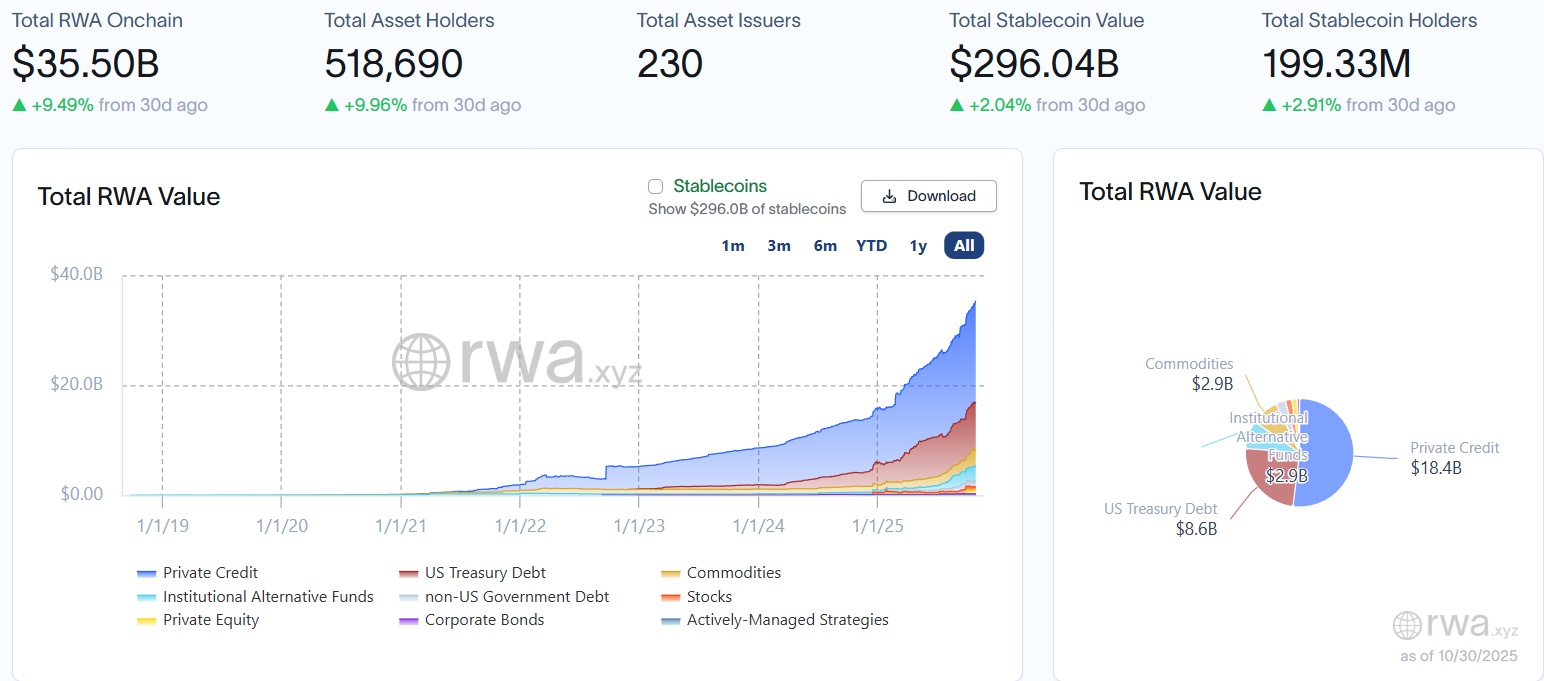Tokenized real-world assets (RWAs) are projected to reach a $2 trillion market capitalization by 2028, driven by DeFi growth and stablecoin liquidity, according to Standard Chartered’s research. This expansion will challenge traditional finance with efficient blockchain-based systems.
-
$750 billion in money-market funds and tokenized US stocks each, per Standard Chartered projections.
-
Stablecoin supply hit a record $300 billion, fueling DeFi’s self-sustaining growth cycle.
-
RWAs currently stand at $35 billion, implying over 57-fold growth in three years, based on RWA.xyz data.
Discover how tokenized RWAs could hit $2T by 2028 amid DeFi boom. Explore Standard Chartered’s insights on stablecoins and blockchain efficiency. Stay ahead in crypto investments today.
What are the projected growth trends for tokenized real-world assets in DeFi?
Tokenized real-world assets (RWAs) are expected to achieve a cumulative value of $2 trillion within the next three years, as global capital and payments increasingly shift to blockchain platforms, according to a report from investment bank Standard Chartered. This growth stems from the “trustless” nature of decentralized finance (DeFi), which positions it to rival traditional financial systems dominated by centralized institutions. The projection highlights DeFi’s role in tokenizing assets like stocks, funds, and real estate for greater efficiency.
How are stablecoins driving the expansion of tokenized RWAs?
Stablecoins have become a cornerstone for DeFi’s evolution, with their total supply surpassing $300 billion on October 3, marking a 46.8% increase year-to-date and establishing a record high. This liquidity influx creates a “self-sustaining cycle” in DeFi, where increased liquidity spurs new financial products, and those products attract even more liquidity, as explained by Geoff Kendrick, Standard Chartered’s global head of digital assets research. Kendrick emphasized that “stablecoin liquidity and DeFi banking are important pre-requisites for a rapid expansion of tokenized RWAs,” forecasting exponential growth in this sector. Current RWA value sits at approximately $35 billion, per data from RWA.xyz, setting the stage for substantial scaling if regulatory hurdles are navigated successfully.

Source: RWA.xyz
The report details a breakdown of the anticipated $2 trillion RWA market: $750 billion allocated to money-market funds, $750 billion to tokenized US stocks, $250 billion to tokenized US funds, and $250 billion to less liquid areas such as private equity, commodities, corporate debt, and tokenized real estate. This diversification underscores RWAs’ potential to integrate real-world value into blockchain ecosystems, enhancing accessibility and reducing intermediary costs. Standard Chartered’s analysis draws on market trends observed in DeFi protocols, where tokenized assets have already demonstrated resilience amid broader crypto volatility.
Regulatory clarity remains a pivotal factor in realizing this potential. The investment bank noted that uncertainty, particularly if comprehensive crypto legislation is not enacted before the 2026 midterm elections under the current administration, could impede progress. Experts like Kendrick stress the need for supportive policies to foster innovation without stifling security. In parallel, DeFi’s applications in payments and investments are gaining traction, with stablecoins serving as a bridge between fiat and digital economies.
The interplay between stablecoins and RWAs exemplifies DeFi’s maturation. As liquidity pools deepen, protocols can support complex financial instruments, from yield-generating funds to collateralized lending. Data from on-chain analytics platforms corroborates this trajectory, showing steady inflows into RWA-linked tokens despite periodic market corrections.
Frequently Asked Questions
What factors will drive tokenized RWAs to a $2 trillion valuation by 2028?
Key drivers include the migration of global capital to blockchain for efficiency, stablecoin liquidity exceeding $300 billion, and DeFi’s trustless structure challenging traditional finance. Standard Chartered projects $1.5 trillion in tokenized stocks and funds alone, with regulatory progress essential to unlock this growth, based on current $35 billion RWA market data from RWA.xyz.
How does stablecoin growth impact DeFi’s overall ecosystem?
Stablecoin expansion to over $300 billion has initiated a self-sustaining cycle in DeFi, where liquidity enables new products like advanced lending and yield farming. This reinforces the ecosystem’s stability, attracting more users and capital, and paves the way for tokenized RWAs to scale rapidly, as noted by Standard Chartered researchers.
Key Takeaways
- Exponential RWA Growth: From $35 billion today to $2 trillion by 2028, driven by blockchain efficiency in asset tokenization.
- Stablecoin Milestone: Record $300 billion supply fuels DeFi liquidity, creating a virtuous cycle of innovation and adoption.
- Regulatory Imperative: Clear legislation is crucial; without it, progress in RWAs and DeFi could face significant delays.
Conclusion
The surge in tokenized real-world assets and stablecoin liquidity signals a transformative phase for DeFi, potentially reaching $2 trillion in RWAs by 2028 as outlined by Standard Chartered. With breakdowns into money-market funds, stocks, and private equity, this shift promises to democratize access to global finance via blockchain. Investors and institutions should monitor regulatory developments closely to capitalize on this self-sustaining growth cycle and position themselves for the evolving digital asset landscape.